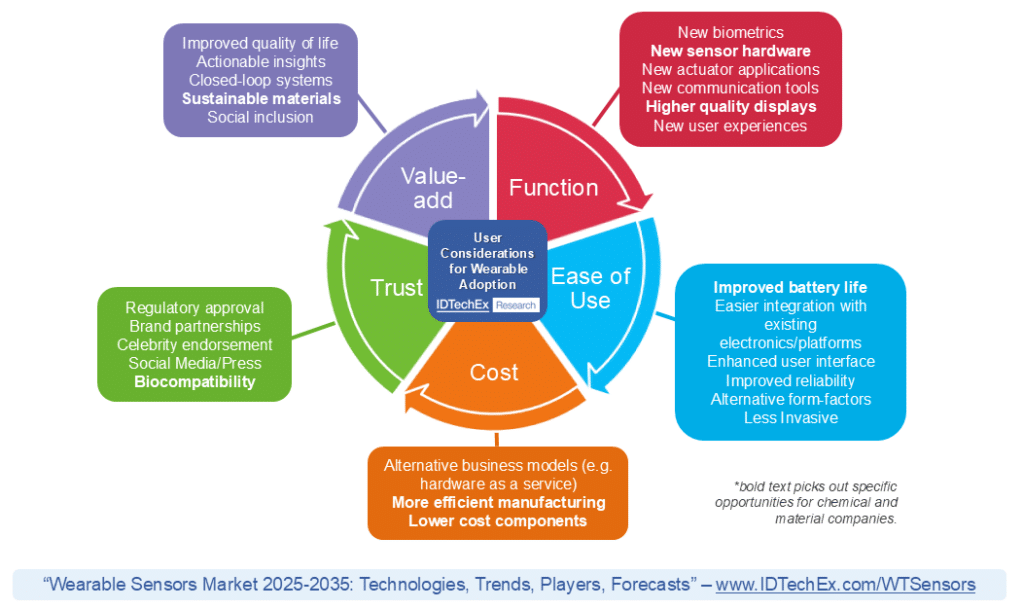User considerations and potential barriers to adoption of new wearable technology.
The wearable sensors market encompasses an array of exciting technologies with the potential to unlock a host of applications in healthcare, extended reality, industrial IoT, and more. Yet as the wearable sensors market matures, there will be some roadblocks for growth ahead. IDTechEx‘s report, “Wearable Sensors Market 2025-2035: Technologies, Trends, Players, Forecasts“, provides insight into how wearable sensors could be integrated into society in the long term.
In this article, IDTechEx outlines three challenges facing the wearable sensors market and some potential solutions which will see the market size grow to US$7.2 billion with a CAGR of 5% by 2035.
Unclear value propositions
We have become accustomed to wearable products hitting the market which can measure our activity levels during exercise, analyze our sleep, and even provide insights into our health. Some medical wearables are designed specifically to collect vital signs for remote monitoring, and to expand the range and accuracy of accessible metrics.
However, as time goes on, it is becoming harder for new OEMs to create products with a differentiated value proposition from existing tech. This is partly due to the limits of what data can be collected using a combination of motion sensors and optical sensors. Expanding into a more advanced suite of metrics comes with more pressure to fulfill regulatory obligations and demonstrate clinical efficacy, as evidenced by the perhaps stalled pursuit for a wearable blood pressure sensor market to become established.
Another factor in unclear value propositions is competition with alternatives to wearables for continuous monitoring such as cameras, smart-home sensors and ‘nearables’. Take, for example, baby monitoring, where smart-sock solutions are in competition with newly AI-enabled camera systems.
The route to overcoming these challenges is in developing solutions that address the higher-level needs of potential customers. This includes improving quality of life, providing actionable solutions insights, enabling closed-loop systems, or improving social inclusivity.
Ease of use
Wearables, at their best, make access to technology easier and more seamless. However, adding new functionalities while maintaining superior ease of use is a major challenge.
One element of this hurdle is related to battery life. Future devices will likely require more power but demand smaller and lighter batteries. Smart glasses are a core example of this. The pressure is on battery developers to increase energy density to a degree that is impactful for wearables and applications like electric vehicles. There is a strong relationship between the success of these innovations and the likelihood for future products to be fashionable and socially acceptable, with the technology ultimately needing to be as discrete or imperceptible as possible.
Battery life aside, invasiveness is another consideration that continues to drive wearable innovations to improve ease of use. Often, the idea of wearables and non-invasiveness go hand in hand. Yet still, minimally invasive continuous glucose monitors have perhaps been one of the most disruptive wearable products to come to market in the last decade. As a result, there is still a gap for more truly non-invasive technologies. This includes products such as electronic skins or sweat sensors. The challenge is that many of the use cases for truly non-invasive skin patches are medical and have a high bar for performance which is harder to achieve or clinically validate.
Costs
Thirdly, consumers globally are acutely aware of rising costs of living and economic pressures. Potential customers of new wearables have less disposable income to spend on what are often high-cost items. Even the few hundred dollars needed for established and competitive sectors like smart watches is significant for many households, never mind the thousands or tens of thousands needed for some of the latest wearable sensor-enabled gadgets.
Alternative business models are one method of overcoming the high up-front costs associated with wearable device purchases. This can include subscriptions or ‘hardware as a service’ approaches and discounted devices in exchange for data. This has proved successful for players like Whoop and Vitality Health, respectively.
Market outlook
Three major challenges facing the wearables industry are: adding value, maintaining ease of use and reducing costs. Yet with these challenges also come opportunities to create solutions to overcome them. This is not only about designing new wearable sensors, but also creating new business models and investing the time and money required to overcome regulatory hurdles.
For more information about any of the technology trends featured in this article, see the latest IDTechEx report, “Wearable Sensors Market 2025-2035: Technologies, Trends, Players, Forecasts“. This report provides insight into how wearable sensors could be integrated into society long term, and forecasts the market to reach US$7.2 billion by 2035. Downloadable sample pages are available for this report.
For the full portfolio of wearable technology market research available from IDTechEx, please see www.IDTechEx.com/Research/WT.
Dr. Tess Skyrme
Principal Technology Analyst, IDTechEx
About IDTechEx
IDTechEx provides trusted independent research on emerging technologies and their markets. Since 1999, we have been helping our clients to understand new technologies, their supply chains, market requirements, opportunities and forecasts. For more information, contact [email protected] or visit www.IDTechEx.com.


